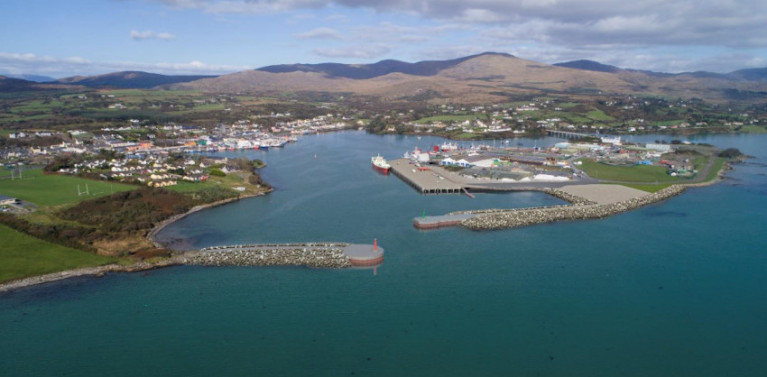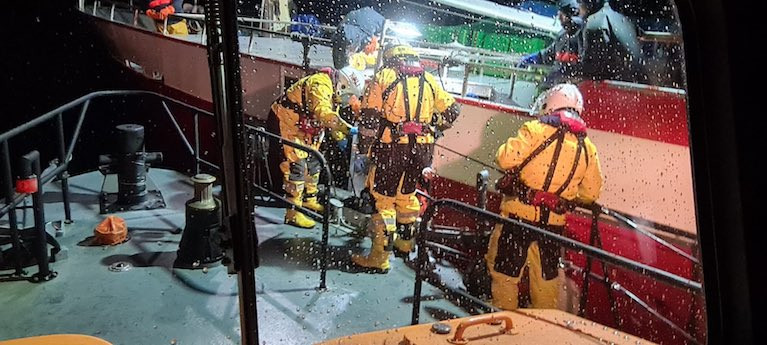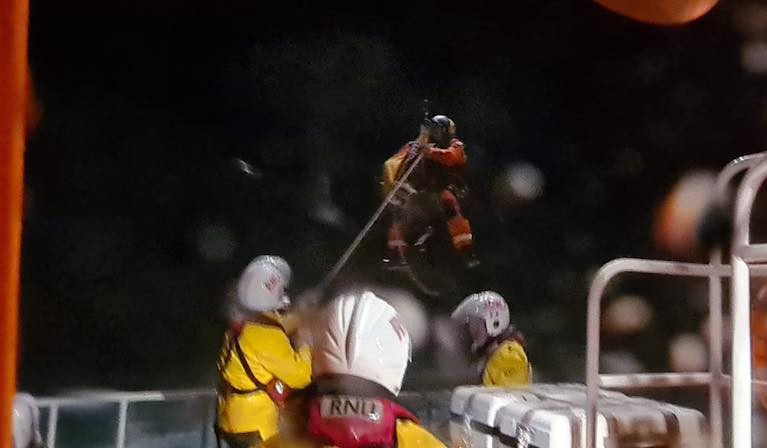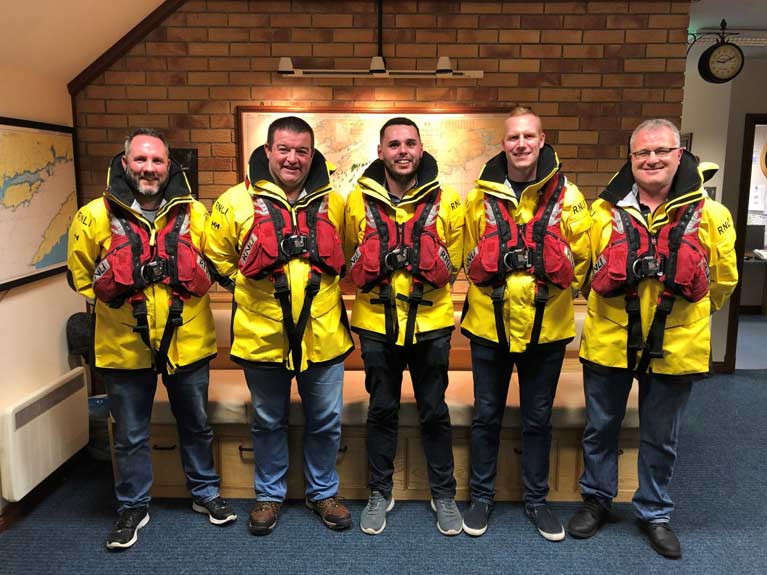Displaying items by tag: castletownbere
Castletownbere RNLI lifeboat in West Cork was launched on Saturday 25 June 2022 at 10.05 pm last night to go to the immediate assistance of two sailors who were crossing the Atlantic and had run into challenging weather and needed assistance.
A Vermont-based couple had set out in their 37-foot yacht from Boston a number of weeks ago and were crossing the Atlantic on route to Scotland.
At 5:30 pm yesterday evening, the Irish Coast Guard’s Marine Research Coordination Centre in Valentia advised the yacht to change course and make for Castletownbere due to deteriorating weather conditions.
As the evening progressed and weather conditions became increasingly challenging Castletownbere lifeboat, ‘Annette Hutton’, was tasked at 10.00 pm and launched immediately under the command of Coxswain Dean Hegarty with crew Dave O’Donovan, David Lynch, Marc O’Hare, Donagh Murphy and Dion Kelly.
 Castletownbere lifeboat, ‘Annette Hutton’, was tasked at 10.00 pm and launched immediately
Castletownbere lifeboat, ‘Annette Hutton’, was tasked at 10.00 pm and launched immediately
The yacht was located at 10:46 pm. ten miles South-West of Castletownbere – conditions on scene were Westerly Force 6/7 winds and a 3-metre sea swell.
A local fishing boat assisted while the lifeboat escorted the yacht. Once in calmer waters, a lifeboat volunteer went aboard to assist with berthing the yacht at Castletownbere pier. When ashore, the sailors had refreshments in the lifeboat and expressed their gratitude to the Irish Coast Guard, The Castletownbere lifeboat and the skipper of the local trawler. One of the sailors commented: ‘It was so reassuring to see the lifeboat coming – we were tired and sea conditions were challenging and we are so delighted to be safe and on dry land now!’
This was Castletownbere lifeboat's second call-out in two days – on Saturday, the lifeboat was involved in a multi-agency search for a missing person in the Ballylickey area.
Irish Lights is recruiting for a Local Contact in Castletownbere. This part-time role is a critical and responsible position that provides an essential service to our coastal communities.
The role is also responsible for carrying out ground support for Search and Rescue (SAR) helicopter operations for the Irish Coast Guard. The role is based at the Irish Lights helipad in Castletownbere and may, from time to time, be required to travel and work at other locations.
Main Responsibilities will include:
Aids to Navigation: Being the local, on the ground, contact for Irish Lights, in the area. Being familiar with the running of the Aids to Navigation and stations assigned.
Helicopter Operations: Being responsible for carrying out ground support for Irish Lights helicopter operations.
Search and Rescue (SAR): Be available to provide ground support and refuelling services for Search
and Rescue (SAR) helicopter operations when required by the Irish Coast Guard.
Key Requirements:
- Reliable, diligent, conscientiousness and self-motivated person
- Technical background - possess a good standard of technical and administrative skills
- Hold a full current clean Driving Licence
- Reside within 1 hours driving time of Castletownbere Helipad
- Please view the Candidate Briefing Pack on our website for further information on the role and requirements - https://www.irishlights.ie/who-we-are/vacancies.aspx
Closing date is Tuesday, 21 June 2022. Please send CV and cover letter to Gemma Gregan at [email protected].
Castletownbere RNLI Lifeboat Tows Yacht Broken Away From Moorings
Castletownbere RNLI lifeboat was launched last night (Friday 13th August 2021) at 8.20 p.m to go to the immediate assistance of a yacht that had broken away from its mooring at Trafrask on the shores of the Beara peninsula in West Cork.
A member of the public spotted the stricken yacht from the shore and was concerned that the vessel would be washed against the rocky shoreline and become damaged. They telephoned the Coast Guard’s Marine Research Coordination Centre in Valentia to raise the alarm.
Castletownbere lifeboat, ‘Annette Hutton’, was tasked at 8.10 p.m. and launched within ten minutes under the command of Coxswain Dave Fenton with crew Marney O’Donoghue, Martin Cronin, John Paul Downey and Aaron O’Boyle.
The yacht was located at 8.45 p.m. in a small inlet known as Trafrask Bay near Adrigole – the boat was aground with no persons on board. Coxswain Fenton described the conditions onscene as ‘calm’. The lifeboat launched its inflatable Y-boat with two crew members and attempted to tow the yacht. However, the grounded yacht would not move so then a tow was then attached to the lifeboat. The yacht was pulled clear and reattached securely to the mooring.
Commenting on the callout, Lifeboat Operations Manager, Paul Stevens stated that: ‘However minor the problem may seem at the time, members of the public should never hesitate to call 999 or 112 and ask for the Coast Guard - an early response from the emergency services ensures that situations such as this can be dealt with quickly and effectively’.
Castletownbere RNLI were launched this morning (Wednesday 14th July 2021) just before 9.00 a.m. to go to the immediate assistance of a kayaker who had become stranded yesterday evening on the Calf Rock and then went on to rescue his dog ‘Lucky’ who was stranded on the Bull Rock in West Cork.
Yesterday evening, a 50-year-old lone kayaker with his dog landed on the Bull Rock west of Dursey Island. However, when he went to leave the rock, his dog ‘Lucky’ would not come with him. He then paddled to the Calf Rock where he intended to stay the night – however he became separated from his kayak and was stranded on the Calf Rock overnight.
The story began to unfold this morning when a local fishing vessel spotted the man calling for help on the Calf Rock. The vessel raised the alarm and Castletownbere lifeboat was tasked by Valentia Coastguard Radio. The lifeboat ‘Annette Hutton’ was launched within minutes under the command of Coxswain Dean Hegarty with crew Marney O’Donoghue, Kyle Cronin, Mark O’Hare & David O’Donovan,
At 9.40 a.m the lifeboat located the stranded man on the Calf Rock and immediately launched a small dinghy to retrieve him. Coxswain Hegarty complimented the crew as landing at the rock required considerable skill as there was a 2/3 metre run of tide. He was found to be safe and well. The lifeboat then proceeded west to the Bull Rock and again launched its Y boat in similar sea conditions to retrieve the man’s dog. Both man and dog were reunited on board the lifeboat.
Commenting on the callout Castletownbere RNLI Deputy Launching Authority, Felix O’Donoghue, stated: ‘Luckily, other than being cold last night, neither the kayaker or his dog suffered any ill-effects from being stranded on two separate rocks overnight. Callouts like this highlight the need for anyone using the sea to carry a VHF radio to make contact in an emergency.
RNLI Lifeboat Operations Manager, Paul Stevens stated that ‘This is not the first time that someone has been stranded on the Calf Rock. In 1881, when the top of the lighthouse was blown off and swept away in a violent storm, six lighthouse keepers spent 12 days on the rock prior to being rescued. Modern lifeboats, dedicated volunteer crew and good weather meant that this kayaker only spent one night there!
Castletownbere RNLI was launched yesterday evening (Saturday 10th July 2021) just after 7.20 pm to go to the immediate assistance of a lone sailor who had become injured on his yacht off Bere Island in West Cork
Castletownbere lifeboat was tasked by Valentia Coastguard Radio yesterday evening after a yacht approaching Lonehart Harbour on the southern side of Bere Island hit a rock and the sailor was thrown forward resulting in injuries to his face and leg. He immediately radioed for help.
The lifeboat ‘Annette Hutton’ was launched within minutes under the command of Coxswain Dean Hegarty with crew Martin Cronin, Joe Cronin, John Paul Downey, Aaron O’Boyle, Donagh Murphy & David O’Donovan,
At 7.40 pm the lifeboat located the yacht at Island’s End located at the easterly tip of Bere island in calm conditions. A member of the lifeboat crew was transferred aboard to rig a tow and the casualty was brought aboard the lifeboat to receive first aid.
On arrival at Castletownbere RNLI Station, the injured man was met by paramedics from the ambulance service and he subsequently received medical assessment and attention. Meanwhile, members of the lifeboat crew had motored the yacht to a safe berth in Castletownbere harbour.
Commenting on the callout Castletownbere RNLI Deputy Launching Authority, Felix O’Donoghue, stated: ‘The crew are to be complimented for their very swift response this evening and the rescued sailor seemed to be in good spirits when expressing his gratitude.
Expansion Works Begin at Castletownbere’s Dinish Wharf
Major expansion works were set to begin today (Thursday 4 March) for Castletownbere Fishery Harbour Centre at Dinish Wharf.
Works on the €23.5 million project, which had been due to begin in late 2018, will continue on the site until March 2022 and include, but are not limited to:
- Construction of a new quay structure approximately 216m at Dinish Island, including all associated infilling and land reclamation.
- Dredging of a berthing pocket adjacent to the new wharf extension by dredging to a depth of -8.0m Chart Datum.
- Dredging of a navigation channel to a depth of -6.5m Chart Datum.
- Construction of two new breakwater structures.
- Construction of a reclamation area to act as a quay/storage hinterland area.
- Provision of all water, electrical and fuels services.
- Heavy-duty pavement surfacing to new wharf/quay structure area.
- Ancillary marine facilities and services.
- Relocation of navigation lights.
- Revised security and access arrangements for quay facilities.
Civil engineering crews will operate from the adjacent lands, existing harbour infrastructure and from jack-up barges, pontoons, heavy civil engineering plant and machinery, work vessels and platforms. Divers are also employed on site.
For safety reasons, mariners are advised to proceed slowly and with caution in the approach channel to the inner harbour and within the inner harbour area and to give the works a clear berth. Wave-wash from vessels should also be avoided.
Castletownbere RNLI Lifeboat Launch to Ill Fishing Vessel Skipper
Castletownbere RNLI were launched last night (Tuesday 10 February 2021) just after 11.00 pm to go to the assistance of a seriously ill skipper on board a fishing vessel off the West Cork Coast.
Castletownbere RNLI lifeboat was tasked by Valentia Coastguard Radio last night to go to the assistance of a 30-metre Spanish-registered fishing trawler, located south west of Castletownbere which reported that the skipper had suddenly become seriously ill.
The lifeboat was launched within minutes under the command of Coxswain Dave Fenton with crew Marney O’Donogue, John Paul Downey, Kyle Cronin and Donagh Murphy and located the vessel at 12.09 nineteen miles south-west of Ardnakinna lighthouse. Conditions on-scene were challenging with a 3-4 metre swell and gusting east northeast winds up to Force 6.
The lifeboat then escorted the trawler to just inside the mouth of Castletownbere harbour where local pilot went aboard and took command of the vessel. The casualty, a man in his late fifties, was transferred to the lifeboat in calmer waters. The lifeboat then took the casualty to Castletownbere RNLI station where he transferred a waiting ambulance at 2.10 a.m. He was taken to hospital for medical assessment and treatment. Meanwhile, the fishing was safely berthed at Castletownbere Pier. The lifeboat was made ready for service again by 2.20 a.m.
Commenting on the callout Castletownbere RNLI Lifeboat Deputy Launching Authority, Felix O’Donoghue, complimented the crew on its rapid response, maintaining strict COVID-19 protocols and the safe transfer of the ill casualty’.
Castletownbere RNLI lifeboat was launched last night at 22:54 to go to the assistance of a seriously will fisherman on board a fishing vessel off the West Cork Coast.
Castletownbere RNLI lifeboat was tasked by Valentia Coastguard Radio at 22:46 last night to go to the assistance of a 27-metre locally-registered fishing trawler, with six persons on board, located two miles south of Mizen Head which reported that a crewman had suddenly become seriously ill.
The lifeboat was launched within minutes under the command of Coxswain Dean Hegarty and located the vessel west of Sheep’s Head.
Conditions on-scene were difficult with a three metre swell and 25-knot south-westerly winds. Two attempts were made to transfer the casualty from the fishing vessel to the lifeboat but were unsuccessful due to unfavourable conditions. The lifeboat then escorted the trawler to just inside the mouth of Castletownbere harbour where the casualty, a man in his late forties, was transferred to the lifeboat in calmer waters.
 The Coastguard helicopter 115 lowered a winchman onboard the Castletownbere RNLI
The Coastguard helicopter 115 lowered a winchman onboard the Castletownbere RNLI
The Shannon-based Sikorsky Irish Coastguard helicopter Rescue 115 was tasked and met with the lifeboat in Bantry Bay. The helicopter lowered a winchman and the casualty was successfully transferred to the helicopter for immediate evacuation to Cork University Hospital.
Commenting on the callout Castletownbere RNLI Lifeboat Deputy Launching Authority, Brendan O’Neill, complimented the crew on its rapid response to the call-out and thanked the coastguard for its cooperation in making this call-out successful.
Castletownbere RNLI Launch to Yacht That Broke Mooring
Castletownbere RNLI were launched this morning (Friday 21st August 2020) at 09:03 to assist a yacht which had broken away from its moorings off the Bere Island in West Cork.
The yacht was spotted drifting in the channel between Bere Island and the mainland and being blown towards the shore in very windy conditions. A concerned member of the public raised the alarm requesting immediate assistance.
The lifeboat was launched within minutes under the command of Coxswain Dean Hegarty and located the vessel drifting towards the shore in Force 6/7 winds. There was nobody aboard the yacht and no damage was sustained. At this stage, a local boat from Bere Island had the yacht taken under tow and the lifeboat accompanied both vessels to safety.
Commenting on the callout Castletownbere RNLI Lifeboat Deputy Launching Authority, Felix O’Donoghue commended the member of the public for raising the alarm and therefore avoiding the yacht being blown ashore.
A new book providing a collection of first-hand accounts of some of the most dramatic rescues carried out by RNLI lifesavers around Ireland and the UK over the past 20 years, features an incredible feat of bravery by a Cork lifeboat crew. Told in the words of Castletownbere RNLI Coxswain Dean Hegarty, it provides a first-hand account of the dramatic rescue of a fishing crew in storm force conditions after their vessel lost all power at the harbour entrance of Castletownbere in West Cork. Six lives were saved that night and the Coxswain is set to receive a medal for gallantry, and the crew and launching authority, letters of thanks from the Institution. The book Surviving the Storms goes on sale today (Thursday 11 June) with royalties from all sales supporting the lifesaving charity.
 Surviving the Storms features 11 stories of extraordinary courage and compassion at sea
Surviving the Storms features 11 stories of extraordinary courage and compassion at sea
Surviving the Storms features 11 stories of extraordinary courage and compassion at sea, providing a rare insight into the life-or-death decisions the RNLI have to make when battling the forces of nature and saving lives.
The Castletownbere RNLI rescue from 2018 is included with those of a Northern Ireland lifeboat mechanic who swam into a cave to rescue two teenage boys when they became trapped with a rising tide in dangerous conditions and lifeguards in Cornwall saving the lives of people, moments away from drowning. This book has an abundance of drama told from the unique perspective of the RNLI lifesavers, as well as those they rescue.
In an extract from the book Dean Hegarty, who at 24-years old had been on the lifeboat crew for five years and was a recently appointed Coxswain on his second callout in charge, explains what he saw when he and his lifeboat crew came on scene.
‘Within 10 minutes of the original mayday call, we were on the scene. What I saw when we arrived, I can’t lie; It almost gave me a heart attack. The way the tide was going out and the wind was coming in, it was churning the sea up and creating a big, watery explosion. There were huge swells reaching six metres, the height of a two-storey house, tossing the fishing boat around like a rag doll and pushing her ever closer to the sixty-metre cliffs to the west of the harbour mouth. The gales were now peaking at storm force 11. My heart started to race as I watched waves crashing up against the cliffs, with the vessel only 30 or so metres away from the rocky shoreline.’
RNLI Chief Executive, Mark Dowie, said: ‘Surviving the Storms is a wonderful account of selflessness and bravery although there is no book big enough to do justice to every RNLI rescue and rescuer. We have hundreds of lifeboat stations and thousands of crew members and lifeguards all dedicated to saving lives. Between them, they’ve helped so many people survive the storms and I’m proud of every one of them.’


































































